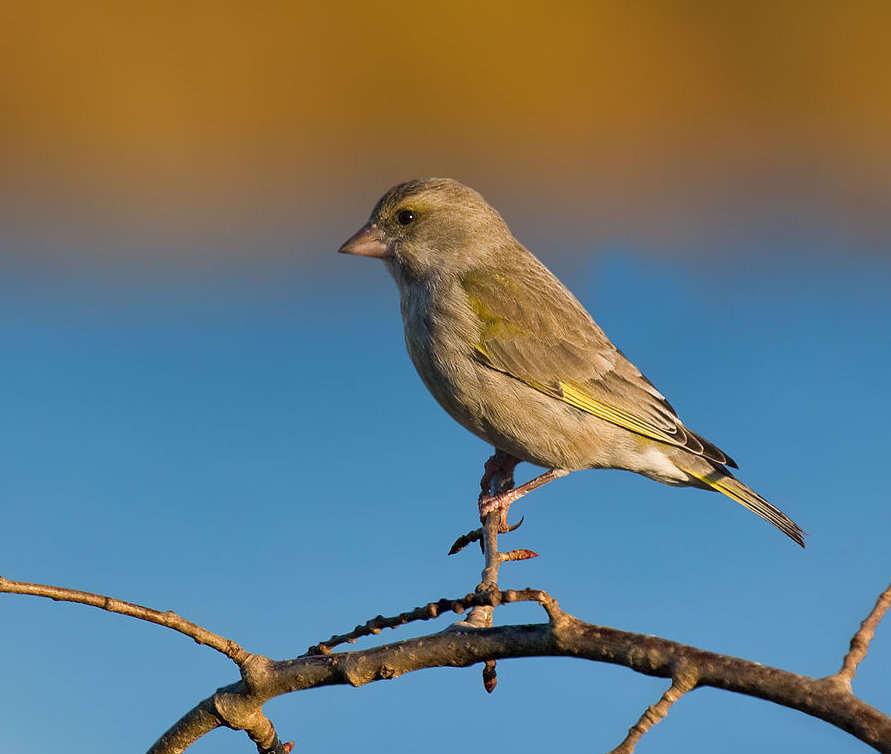Garden Wildlife
Garden Wildlife


Male Female
What do they look like?
While similar in shape to the other common finches, greenfinch is a larger (15cm) and bulkier, with a correspondingly stout bill – they are a bit bigger than house sparrows and distinctly bigger than robins. Males are dull green all over apart from a bright flash of yellow along the edge of their wing, and a patch of yellow at each side of the base of the tail. Females tend to be a little browner green, with evident streaking on the underside and back but they still have the yellow flashes. The juveniles are more clearly streaked with a face more marked out than the adults. The bill looks powerful, is horn-coloured, very broad at the base and short. See our finches page for comparison with other species.
What do they sound like?
The song is a musical twittering superficially similar to the goldfinch, but louder and lower in pitch. It is accompanied by a loud nasal ‘wheeze’ every so often, which is specific for greenfinch.
Greenfinch Chloris chloris
Greenfinches live up to their name – in good light they are unmistakably green!

What do they eat?
The bill shape and size reveals the diet of greenfinches – predominantly larger seeds and fruits. They also eat some insects, especially when feeding the young. They are very fond of the sunflower seed put out at feeding stations.
What do they do?
Greenfinches are open landscape birds, but now more common in rural and suburban habitats than elsewhere. They tend to live in flocks throughout the year, often nesting close together in hedgerows and scrub. The males can be heard in treetops and on chimneys, roofs and other high places singing and wheezing in spring and summer. Groups frequently come to garden feeders later in the summer and in the winter. Most UK birds stay for the winter, maybe moving south and west a bit in colder weather, and they are joined by incoming birds from Northern Europe at that time.
How are they doing?
Greenfinches used to be much more abundant, booming in population during the late 20th century but the population has subsequently crashed. The BTO Breeding Bird Survey for 2019 records a 64% decline over the last 20 years, starting in 2006. This is largely due to the infectious disease Trichomonosis, to which greenfinches seem particularly vulnerable. This parasitic infection inflames the throat and oesophagus of the birds making it impossible for them to swallow food or drink, and they quickly become passive, comatose and die. The parasite can be passed on at feeding stations, so good hygiene at the feeding station is vital to protect birds from this disease.
Finding out more:
BTO profile on greenfinch
RSPB profile on greenfinch
BTO page on Trichomonosis
Our How to guide on bird feeding
Page written by Roy Smith, compiled by Steve Head
Joost van Bruggen, XC649459. Accessible at www.xeno-canto.org/649459.
Albert Noorlander, XC642462. Accessible at www.xeno-canto.org/642462.
In flight the contact call is typical of the finches, but quite distinctive:
Greenfinch Chloris chloris
Greenfinches live up to their name – in good light they are unmistakably green!

Male Female
What do they look like?
While similar in shape to the other common finches, greenfinch is a larger (15cm) and bulkier, with a correspondingly stout bill – they are a bit bigger than house sparrows and distinctly bigger than robins. Males are dull green all over apart from a bright flash of yellow along the edge of their wing, and a patch of yellow at each side of the base of the tail. Females tend to be a little browner green, with evident streaking on the underside and back but they still have the yellow flashes. The juveniles are more clearly streaked with a face more marked out than the adults. The bill looks powerful, is horn-coloured, very broad at the base and short. See our finches page for comparison with other species.
What do they sound like?
The song is a musical twittering superficially similar to the goldfinch, but louder and lower in pitch. It is accompanied by a loud nasal ‘wheeze’ every so often, which is specific for greenfinch.
In flight the contact call is typical of the finches, but quite distinctive:
What do they eat?
The bill shape and size reveals the diet of greenfinches – predominantly larger seeds and fruits. They also eat some insects, especially when feeding the young. They are very fond of the sunflower seed put out at feeding stations.
What do they do?
Greenfinches are open landscape birds, but now more common in rural and suburban habitats than elsewhere. They tend to live in flocks throughout the year, often nesting close together in hedgerows and scrub. The males can be heard in treetops and on chimneys, roofs and other high places singing and wheezing in spring and summer. Groups frequently come to garden feeders later in the summer and in the winter. Most UK birds stay for the winter, maybe moving south and west a bit in colder weather, and they are joined by incoming birds from Northern Europe at that time.
How are they doing?
Greenfinches used to be much more abundant, booming in population during the late 20th century but the population has subsequently crashed. The BTO Breeding Bird Survey for 2019 records a 64% decline over the last 20 years, starting in 2006. This is largely due to the infectious disease Trichomonosis, to which greenfinches seem particularly vulnerable. This parasitic infection inflames the throat and oesophagus of the birds making it impossible for them to swallow food or drink, and they quickly become passive, comatose and die. The parasite can be passed on at feeding stations, so good hygiene at the feeding station is vital to protect birds from this disease.
Finding out more:
Page written by Roy Smith, compiled by Steve Head


























